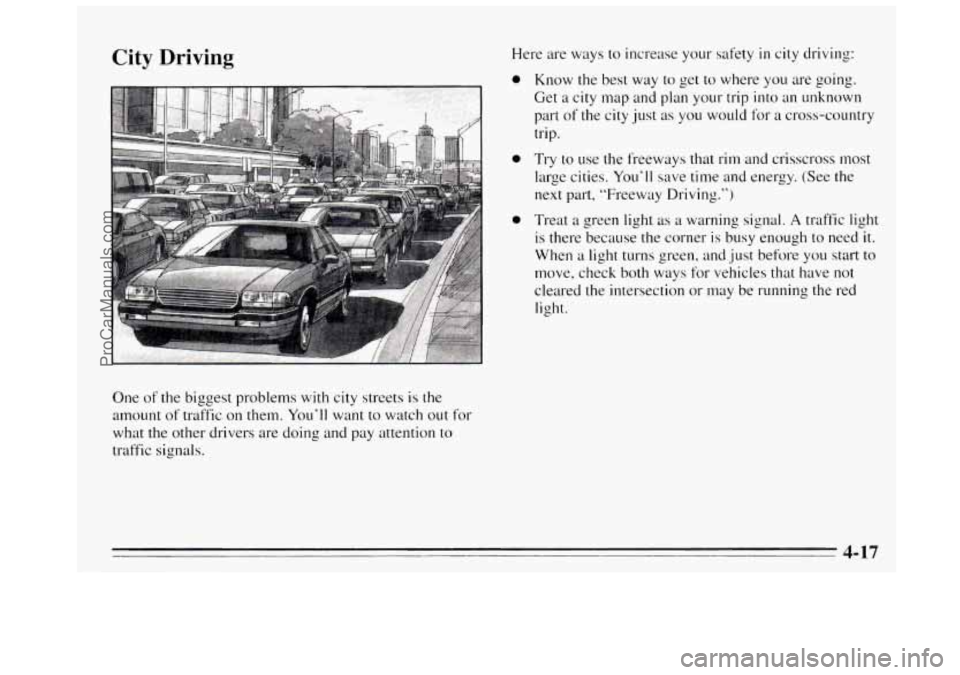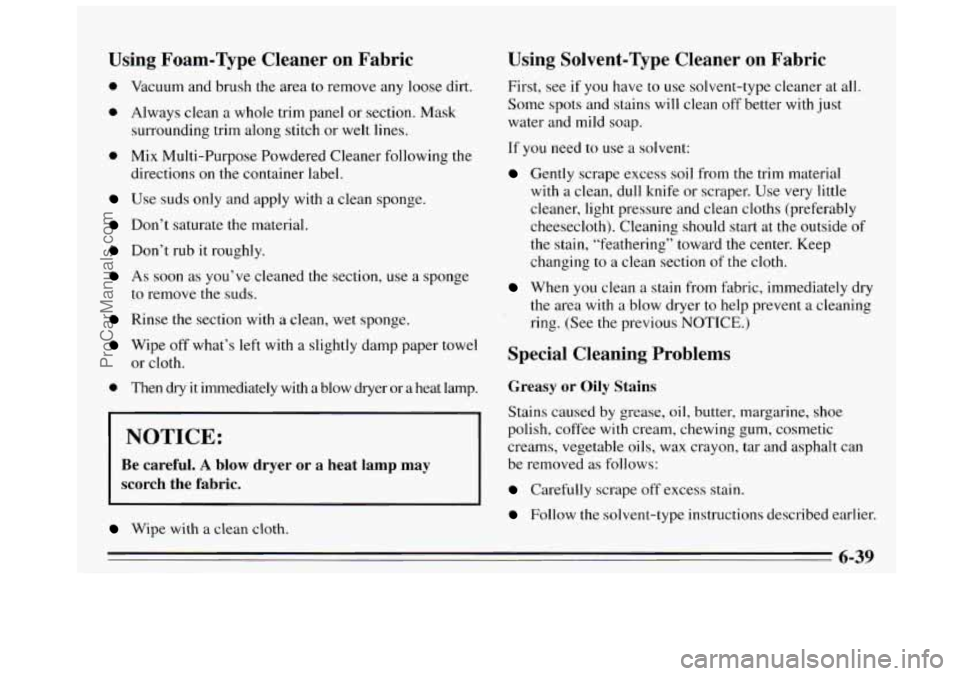rim BUICK REGAL 1995 Owners Manual
[x] Cancel search | Manufacturer: BUICK, Model Year: 1995, Model line: REGAL, Model: BUICK REGAL 1995Pages: 340, PDF Size: 17.16 MB
Page 34 of 340

How does an air bag restrain?
In moderate to severe frontal or near-frontal collisions,
even belted occupants
can contact the steering wheel or
the instrument panel. The air bag supplements
the
protection provided by safety belts. Air bags distribute
the force of the impact more evenly over the occupant’s
upper body, stopping the occupant more gradually. But
air bags would not help you in many types of collisions,
including rollovers and rear and side impacts, primarily
because an occupant’s motion is not toward the air bag.
Air bags should never be regarded as anything more
than
a supplement to safety belts, and then only in
moderate to severe frontal or near-frontal collisions.
What will you see after an air bag inflates?
After the air bag inflates, it quickly deflates. This occurs
so quickly that some people may not even realize the air
bag inflated. Some components of the air bag module
in
the steering wheel hub for the driver’s air bag, or the
instrument panel for the right front passenger’s bag, will
be
hot for a short time, but the part of the bag that comes
into contact with you
will not be hot to the touch. There
will be some smoke and dust coming from vents
in the
deflated air bags. Air bag inflation will not prevent the
driver from seeing or from being able to steer the
vehicle, nor will
it stop people from leaving the vehicle. In
many crashes severe enough to inflate an air bag,
windshields are broken by vehicle deformation.
Additional windshield breakage may
also occur from the
right front passenger air bag.
The air bags are designed to inflate only once. After
they inflate,
you’ll need some new parts for your air
bag system.
If you don’t get them, the air bag system
won’t be there to help protect you
in another crash.
A
new system will include air bag modules and
possibly other parts. The service manual for your
vehicle covers the need to replace other parts.
1-22
-- -
ProCarManuals.com
Page 155 of 340

City Driving
One of the biggest problems with city streets is the
amount
of traffic on them. You’ll want to watch out for
what the other drivers are doing and pay attention to
traffic signals. Here are ways to increase
your safety
in city driving:
0
0
0
Know the best way to get to where you are going.
Get
a city map and plan your trip into an unknown
part
of the city just as you would for a cross-country
trip.
Try to use the freeways that rim and crisscross most
large cities.
You’ll save time and energy. (See the
next part, “Freeway Driving.”)
Treat
a green light as a warning signal. A traffic light
is there because the corner is busy enough to need it.
When a light turns green, and just before you start to
move, check both ways for vehicles that have not
cleared the intersection or may be running the red
light.
4-17
ProCarManuals.com
Page 247 of 340

Using Foam-Type Cleaner on Fabric
0 Vacuum and brush the area to remove any loose dirt.
0 Always clean a whole trim panel or section. Mask
surrounding trim along stitch or welt lines.
0 Mix Multi-Purpose Powdered Cleaner following the
Use suds only and apply with a clean sponge.
Don’t saturate the material.
Don’t rub it roughly.
As soon as you’ve cleaned the section, use a sponge
Rinse the section with a clean, wet sponge.
Wipe off what’s left with a slightly damp paper towel
0 Then dry it immediately with a blow dryer or a heat lamp.
directions
on the
container label.
to remove the
suds.
or cloth.
NOTICE:
Be careful. A blow dryer or a heat lamp may
scorch the fabric.
Wipe with a clean cloth.
Using Solvent-Type Cleaner on Fabric
First, see if you have to use solvent-type cleaner at all.
Some spots and stains will clean off better with just
water and mild soap.
If you need
to use a solvent:
Gently scrape excess soil from the trim material
with
a clean, dull knife or scraper. Use very little
cleaner, light pressure and clean cloths (preferably
cheesecloth). Cleaning should start at the outside of
the stain, “feathering” toward the center. Keep
changing to a clean section
of the cloth.
When you clean a stain from fabric, immediately dry
the area with
a blow dryer to help prevent a cleaning
ring. (See the previous NOTICE.)
Special Cleaning Problems
Greasy or Oily Stains
Stains caused by grease, oil, butter, margarine, shoe
polish, coffee with cream, chewing gum, cosmetic
creams, vegetable oils, wax crayon, tar and asphalt can
be removed
as follows:
Carefully scrape off excess stain.
Follow the solvent-type instructions aescribed earlier.
6-39
ProCarManuals.com
Page 259 of 340

Fuse
F/INJN
ECM IGN
ELEK
IGN
10
I1
12
13
Description
Fuel Injectors
Powertrain Control Module
(PCM), EGR, CCP, VAPSW, Mass
Air Flow (MAF) Sensor (VIN X
only). Oxy Sensor
Electronic Ignition
(EI) Control
Module
I/P Fuse Block
FAN CONT
#I Relay
Passenger Side Underhood
Electrical Center and
I/P FLW
Blocks: Fuses 5, 14, 23 and 32
FAN CONT #2 Relay and I/P Fuse
Block: Fuse
16. Power Seat
Circuit Breaker
“D”
Relay
14
1s
16
17
18
Description
FUEL PUMP
A/C CMPR
FAN CONT
#2 -- Secondary
Cooling Fan (Passenger Side)
FAN CONT #1 -- Primary
Cooling Fan (Driver Side)
Ignition Relay
6-51
ProCarManuals.com